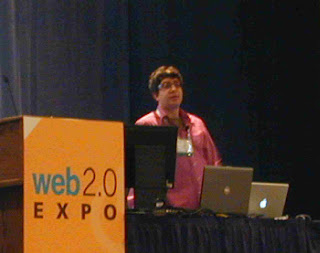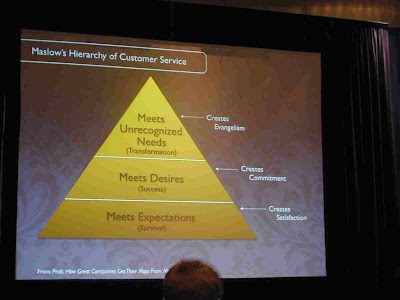The Seduction of the Interface by Chris Fahey [slides 4, 6] (blogger at http://www.graphpaper.com and works at http://www.behaviordesign.com - a web design firm) [slide 5]
Fahey began with a question: How many believe in "love at first sight"? [slide 2] Even when it happens you need to work through it -- that is the meaning of seduction. Think of the fad of mixtapes to impress an amorous venture: you had to do work of compiling the recording, which could be considerable.
Now think of the web: We need "interaction designer," or "user experience designer." They know the secrets of seductive with regards to web design.
Rethink merchandising [slide 7]: It's not about that extra click nor about market strategy but rather about web-centric design.
What is merchandising versus marketing? [slide 8] Merchandising is a subset of marketing. But forget about them. It's not about branding. [slide 9]
Marketing [slide 10] is creating business relationships with partners, and is manifest in advertising, delivering messages, retail environments, immersive advertising. [slide 11]
Merchandising [slide 12] is the strategy and implementation of how a product is presented to customers as they decide whether or not to purchase it. There are three tiers [slide 13]:
- Selling context
- Packaging
- Products that sell themselves.
E-commerce is about selling contexts [slide 18-19]. We're still learning how to optimize automated recommendations, wish lists, product reviews, etc. (so that accurate recommendations are revealed and tied to users' preferences).
2. Packaging [slide 20]. It's about the presentation of an object before you open it - part of the user experience (on Flickr people take and post pics of their unpacking of an object). [slide 21 - think about the success of the L'Eggs panty-hose campaign of 30 years ago.] [slide 22 - an Apple laptop about to be unpacked] Is packaging like a selling contest? [slide 23] Today the box and the store are now the same. For example: Basecamp. [slide 24] The product markets to you directly once you're in the website. [slide 25-26 - from Fahey's Behavior.com] So don't think of your product's box. [slide 27]
3. Products that sell themselves. [slide 28] The seductive qualities must be built into the product. (This subject is discussed in Henry Dreyfuss's book Designing For People.) [slide 29]
Again a definition of mechandising [slide 30]. But we must go beyond merchandising. [slide 31] It's a metaphor for designers. Marketing and design have always have bumped heads with each other. Today they are each other [slides 31-34]
In the Web 2.0 world designers are now responsible for marketing. [slide 35] Think of the product as a vehicle for continuous seduction. Today the new equation is marketing equals design, where design equals all aspects of the user experience.
Web-centric: [slide 36] the broad category of services that are on the web but can exist elsewhere. For the web-centric - the user experience must be about pleasure. [slide 37] It must appeal (if possible) to all the five senses. [slides 38-39; a joke: Homer Simpson's sensory experience] It can be achieved in other ways: through psychological pleasure, e.g. "attractive things work better." (See Don Norman's book Emotional Design [slide 41] and his website as well.) When something pleasures you it primes your mind for more creativity and effectiveness. [slides 42-44]
You don't see web services advertising web companies. On Google? nada, nothing. You don't see TV advertising for faccebook. It goes purely by word of mouth. In traditional mediums, the market has to convince the user that it's great. But in Web 2.0 [slide 45] the user experience is everything.
How the design of the Web 2.0 user experiences changes how products are marketed. [slide 46]
The conversion: [slide 47] An example from yesterday's method of seduction: Think about all that junk snail mail one received from Publishers' Clearing House [slide 48] - their campaign was about submission [slide 49] - that maybe some people would answer their packets.
But today it's not about submission. [slide 50] Seduction is about making someone fall in love with you. [slides 51-54] The conversion method is obsolete. [slide 53] Rather: today's method is connection.
Seduction. We want users to fall in love with us. [slide 55] There are three stages:
- inspire their attention, interest and desire
- draw them in
- capture their ongoing devotion
Look at Margaret Mark and Carol Pearson's book The Hero and the Outlaw: Building Extraordinary Brands Through the Power of Archetypes [slide 59].
Think of users as distinct personalities - You can't do that if you think of them as marketing segments. That's a different way of coming up with ways to communicate and design.
Yahoo's Competitive Spectrum outlines these characteristics: caring, collaborative, cordial, competitive, combative [slide 60).
You can make up your own criteria that will help shape the design process [slide 61). Also think of "user personas" a nd personal useage guidelines [slides 62-63]. These are tools for allowing designers to generate ideas.
Techniques for seduction:
- You need to make the first move!! [slide 64). Use moton, words, video. careful with audio [slide 65].
- Create a sense of mystery [slide 66] (example of upcoming product with ambiguous web front - slides 67-69].
- Appear desirable [slides 70-72], because nothing draws a crowd like another crowd. Present testimonials - not user media testimonials, but real user testimonials, too.
Flatter them [slide 73]. Assume that they're slightly more sophisticated than the marketing data says. - Tempt them [slide 74].
Seduction is not just about love but also abandoning responsibilities to one's childlike desires - indulging in products like a fantasy. [slide 78: note the entrancing nature of this bookstore with an entrancing name.] [Slide 79 shows examples of types of victims from Greene.]
Have a sense of humor [slide 80]. Why not spice up the cancel button? How about this slide [slide 81] which suggests "just kidding - i remember my password now."
Be stylish [slide 82]. You can redesign based on style since don't want to be out of date.
Affordances of desire [slide 83]. You imagine a website as part of your life. Think of umbrellatoday.com. Or Dopplr [slide 84) where you can share your travel itineraries.
Distract them from their responsibilities [slide 85].
(I forget what was the point of the two slides, 86-87, showing 43 Folders and a thought about redirecting one's energy.]
Stage three: Capture their ongoing devotion [slide 88].
Continually grow [slide 89]. Create an endless cycle of continuous seduction. Fahey showed the example of how Nike has created website [slides 90-91] for runners where probes are placed in your sneaker and iPod, to allow you to create charts of running progress which you can share. Of course, there are also widgets for you to put on your blog.
The design process [slide 92]: plan it out: goals, scenarios, and paths [slides 93-94]. Remove obstacles - users know what they want [slides 95-99].
Plan for delight [slide 100]. Plan for these enjoyable user experiences.
Evaluate with psychology and emotion [slide 101].
Understand yourself [slide 102]. What kind of seducer are you? [slides 103]. Perhaps you're one of the 30-second seducers [slide 104] - from 30-Second Seduction by Andrea Gardner.
Closing thought [slide 105] seduction is: [slide 106-111]
- Is about love, togetherness, enchantment and pleasure.
- is user-centric. not victimization.
- is a journey
- is proactive
- and nothing to be squeamish about!










